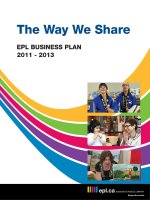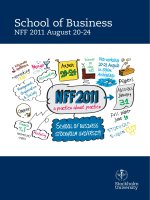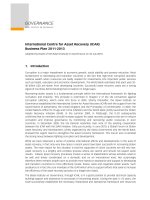efdm business branding 2011
Bạn đang xem bản rút gọn của tài liệu. Xem và tải ngay bản đầy đủ của tài liệu tại đây (2.99 MB, 12 trang )
The Business of Branding 2011
An international report on branding, marketing and business school perceptions,
drawing on the views of current students, alumni, faculty and administrative staff.
August 2011 :: Andrew Crisp, Sarah Hardcastle
E XECUTIVE SUMMAR Y
carringtoncrisp
© CarringtonCrisp August 2011
All rights reserved.
Reproduction in whole or part prohibited without prior permission of the authors.
No part of this publication may be reproduced, stored in a retrieval system or transmitted
in any form or by any means without prior permission of CarringtonCrisp.
the business of branding
Introduction
The Business of Branding study was first run in 2004. Since that
time more than 100 business schools have taken part in the study
from 25 countries. Nearly 70,000 respondents have completed the
study, providing a wealth of data for business schools considering
how best to position themselves and enhance their marketing
effectiveness.
Research was conducted by CarringtonCrisp in partnership with
the Association of Business Schools (ABS), EFMD, the Global
Business Schools Network (GBSN), Consejo Latinoamericano de
Escuelas de Administracion (CLADEA) and the Canadian Federation
of Business School Deans (CFBSD) during March/April/May 2011
using an online questionnaire. In addition, specialist support was
provided by Giselle Weybrecht for the section on Sustainability.
Figure 1. Reasons given for indicating that a school has a strong reputation
Had a strong reputation for quality through accreditation by EQUIS, AACSB or
AMBA
Had a strong international reputation
Had a strong reputation for high quality teaching staff
Had a strong academic reputation
Had a strong reputation for good value for money
Had a strong reputation for flexible study patterns allowing students to continue
working while studying
Had a strong reputation for links with business and industry
Had a strong reputation for my chosen course/subject
Had a strong reputation for enhancing career prospects
Had a strong reputation as one of the best business schools in the country
Had a strong reputation based on the excellence of its research
Had a strong reputation largely based on its performance in rankings
Had a strong reputation largely based on its history
0.00%
Alumnus
PhD/DBA
Other Business Masters
10.00%
20.00%
MBA PT/Executive
30.00%
MBA FT
40.00%
50.00%
60.00%
First degree
3
carringtoncrisp
Data collected over six weeks during March, April and May 2011
generated a total of 8011 responses. The response was drawn from
business schools in eight countries. Respondents were drawn from
125 nationalities. Thirteen nations had more than 1% of the total
response, but the largest responses were drawn from Australian,
German, British, Nigerian, South African, Swiss and French nationals.
First degree students (1903) and alumni (1576) were the largest
respondent groups in this year’s study. Across the sample respondents
were split almost 55:45 male to female.
The following summary is based on the key findings from this year’s study.
Careers are key before, during and after
Before choosing where to study many students consider the likely
impact of their choice on their future career prospects. While they
are studying, students are increasingly looking for help finding a
placement, sensing that experience will be as valuable on their CVs
as will their degree. An increasingly valuable career service noted by
many of the respondent student groups was having ‘student CV’s on
a secure website that can be searched by employers’.
Figure 2. Ways of assessing value for money
Alumnus
PhD/DBA
I assess against my perception of the reputation of the
school
Cost of my preferred course compared with the budget
I had set
Other Business Masters
Cost of living including accommodation, travel, food and
books at my preferred business school compared with
other business schools
/ƚ͛Ɛ Ă ĚĞĐŝƐŝŽŶ ƚŚĂƚ / ŵĂĚĞ ďĂƐĞĚ ŽŶ Ă ĨĞĞůŝŶŐ ƌĂƚŚĞƌ ƚŚĂŶ
hard evidence
MBA PT/Executive
Likelihood of achieving the career outcome I desire
Cost of my preferred course measured against cost of
courses at other schools
MBA FT
First degree
0.00%
4
10.00%
20.00%
30.00%
40.00%
50.00%
60.00%
70.00%
the business of branding
Figure 3. Describing your business school to a potential student by participating school
9.00
8.00
7.00
6.00
5.00
4.00
School 1
School 2
School 3
School 4
3.00
School 5
School 6
2.00
1.00
.00
School 7
School 8
School 9
School 10
School 11
Post-graduation alumni are looking to their school to help with their
career development through advice, networks and even sourcing
opportunities. As more schools look to enhance alumni fundraising,
provision of alumni career services may produce greater financial support.
Brand, price and reputation
In the 2011 study almost 65% of all respondents state that they
believe ‘My school has a strong clear brand which is widely
recognised and understood’; historically this figure has been closer
to 55%. The best performing schools tend to have positive brand
recognition at around 75%.
Stronger brands often mean higher prices. In the UK market place
with the significant increase in undergraduate fees planned for 2012,
brand may become more important than ever. However, there is
something of a chicken and egg relationship – will higher fees lead to
stronger brands or will brands have to strengthen to ensure that
higher fees are sustainable?
Track record and career enhancement are reflected in the key drivers
of reputation in this year’s study. Whether it’s rankings, accreditation
or perception of quality, all are identified as having a significant
impact on reputation. Add in an ability to enhance career prospects
and flexibility for part-time students and you have all the elements of
reputation to drive a strong brand.
5
carringtoncrisp
Does cost count?
Higher fees will undoubtedly have a negative impact on decisions to
study, however what is meant by ‘higher’ will change from student to
student. Students when confronted with actual numbers and different
payment terms may have a different opinion as to whether they would
or would not go to business school/university. When it comes to
money, choices are about more than just fees.
Cost of living, especially when compared between countries, can
make a difference in where a student decides to study. However,
students are prepared to pay more if they feel they have a better
chance to get a more highly paid job on graduation or receive better
support in finding employment. Cost perceptions also vary
significantly between institutions.
For those schools with a negative cost-quality differential, suggesting
poor value for money, the task is significant – how to improve
perceptions of value when it is almost impossible to reduce costs for
students.
When judging value for money students have become increasingly
sophisticated. All audience groups highlighted two considerations
when assessing value for money:
• The likelihood of achieving the career outcome that I desire
• The cost of my preferred course measured against the cost of
courses at other schools
Another strong consideration when evaluating value for money chosen
by many respondents was:
• I assess against my perception of the reputation of the school
The importance attached to this consideration ties in with the growing
role of brand described elsewhere in this summary.
Where on the web should we be?
The Internet in general and the university/business school website
have the greatest impact on decisions about what and where to study.
However, having a website and being online is not enough. Just as it
used to be key to advertise in publications with the best audience
coverage, so it is now important to use the right Internet tools. Blogs
have some impact, but it’s reasonably limited, some websites of thirdparty media can be useful with particular audiences, but social
networks are the coming force.
6
the business of branding
Newspapers have been in decline since the start of the survey seven
years ago, although in some specific local markets newspapers still
have a role to play in maintaining brand awareness or promoting new
activities through both PR and advertising. Newspapers may also have
a particular role in maintaining awareness and influence among
parents, and have greater impact in their online versions. Similarly,
fairs and exhibitions are beginning to move online and have an
impact in cyberspace.
Despite the growing use of social networking sites, there are still
questions about their current impact in education marketing. A
separate CarringtonCrisp study showed over 80% of students using
social media sites at least once a day, although rarely in connection
with business schools. The same study also showed that there was
growing use of social media sites among prospective students seeking
an authentic voice from alumni and current students at their chosen
business schools.
Figure 4. Ways in which I expect a business school to demonstrate its approach to sustainability
/ ĚŽŶ͛ƚ ĞdžƉĞĐƚ ŵLJ ďƵƐŝŶĞƐƐ ƐĐŚŽŽů ƚŽ ŚĂǀĞ Ă ƉŽƐŝƚŝǀĞ ĂƉƉƌŽĂĐŚ ƚŽ ƐƵƐƚĂŝŶĂďŝůŝƚLJ
To source food locally for campus canteens
By encouraging staff and students to walk or use bicycles
By supporting public transport for staff and students
By encouraging recycling on campus
By running campaigns to reduce power and/or water use on campus
By reducing its carbon footprint
By running projects involved in giving back to local, national or international
organisations and communities
Through being listed in business school sustainability rankings
Through the content of its programmes
0.00%
Alumnus
PhD/DBA
Other Business Masters
10.00%
20.00%
30.00%
MBA PT/Executive
40.00%
MBA FT
50.00%
60.00%
70.00%
80.00%
First degree
7
carringtoncrisp
Sustainability – it’s important, but does it matter?
Large numbers of students believe that sustainability is important for
their business education, but similar numbers didn’t consider it when
deciding what and where to study. More than 60% of all audience
groups said that ‘I didn’t look for information on sustainability when
choosing my business degree’. The data seems to say that promoting
sustainability credentials is unlikely to have an impact on attraction
and recruitment of students.
There is an expectation that sustainability will be demonstrated through
the content of programmes rather than school operations. More than 1 in
4 also said they expected sustainability to be demonstrated ‘by running
projects involved in giving back to local, national or international
organisations and communities’, ‘by reducing a school’s carbon
footprint’ and ‘by encouraging recycling on campus’. Up to 70% of
some audience groups felt that sustainability was presented as an
add on, as a save the world approach, had too few opportunities to
learn about it or was not included at all in their studies.
Figure 5. Methods of accessing fellow alumni
KƚŚĞƌ
dŚƌŽƵŐŚ ĨƌŝĞŶĚƐ
/ŶĨŽƌŵĂů ůŝŶŬƐ
ZĞŐƵůĂƌ ŶĞǁƐůĞƚƚĞƌ
^ŽĐŝĂů ŵĞĚŝĂ ǁĞďƐŝƚĞ
hŶŝǀĞƌƐŝƚLJͬďƵƐŝŶĞƐƐ ƐĐŚŽŽů ƐLJƐƚĞŵ
Ϭ͘ϬϬй
8
ϱ͘ϬϬй
ϭϬ͘ϬϬй
ϭϱ͘ϬϬй
ϮϬ͘ϬϬй
Ϯϱ͘ϬϬй
ϯϬ͘ϬϬй
ϯϱ͘ϬϬй
ϰϬ͘ϬϬй
ϰϱ͘ϬϬй
the business of branding
Figure 6. Reasons for recommending your business school
Academic standards are high
The school helps students become high employable graduates
The school has good links with business and industry
On-site facilities are outstanding
Course content is very applicable to modern business
Teaching staff challenge students to think differently
The quality of students is high
The location of the campus is excellent
There is a good student social life
0.00%
Admin
Faculty
Alumnus
PhD/DBA
10.00%
20.00%
Other Business Masters
30.00%
40.00%
MBA PT/Executive
50.00%
MBA FT
60.00%
70.00%
80.00%
First degree
What price the alumni relationship?
Keeping in touch with alumni should be getting easier. Social networks
and e-communication make it easier to reach alumni wherever they
maybe. However, dedicated websites for alumni have little or no use
according to nearly 40% of respondents and 30% keep in touch with
fellow alumni through social networks rather than school systems. Some
of the contact may be through school run pages on social networks,
but there are many groups where a school is not formally involved.
Effective alumni relations mean adding value whether it’s in the
experience or the communications. Electronic newsletters are the most
popular benefit received by alumni. Commercial discounts were the
least valued benefit.
Success also requires good internal communications, making sure that
staff understand the benefit of investment in alumni relations, but
more than a third of faculty are unclear about the purpose of alumni
relations at their school.
9
carringtoncrisp
Fundraising appears to be a growing strand of alumni relations at
many business schools outside the US, where it has long been a
feature. Less than a quarter of alumni in the study said that there
were no circumstances under which they would consider a financial
appeal. The two reasons that were most likely to motivate support for
a financial appeal, selected by more than 40% of the sample were, if
it reduced a personal tax bill or when individual income reached a
certain level. Only 15% were likely to support fundraising for a new
building programme, while almost double that number would give to
an appeal to ensure continuing and wider access for future students.
It’s not just career
More than 70% of all audience groups say they would always or in
most cases recommend their business school to prospective students
and it’s not just because they’ve got a good job at the end of their
studies. Of course, career counts, but it’s also about academic
standards and challenging teaching staff.
Fewer than 10% of all audience groups across this year’s study say
that it is unlikely or that they would not recommend their business
school to prospective students. The two main reasons for not
recommending were:
• Course expectations were not met
• The quality of teaching was poor
Branding, whether within a university or as a stand alone business
school, is set to become ever more important as fees rise and
international competition intensifies. Understanding what lies behind
a reputation and perceptions of competitors will be key to continued
success. Whether it’s cost, career outcomes, historic reputation or
academic standards, knowing what matters to students and others
involved in decision making will offer opportunities to enhance
marketing effectiveness and value for money in marketing spend.
10
the business of branding
The Business of Branding can
tell you:
• How your business school is
perceived?
• What are its strengths and
weaknesses, and those of
your key competitors?
• What marketing activity has
the greatest impact?
• Where to get the best return
from your marketing spend?
• How to improve your career
services?
• How to strengthen your
alumni relations?
• What role sustainability
should play in your offer,
curriculum and operations?
and
• How to grow the reputation
of your programmes and
stand out in a crowded and
competitive market?
Each participating school receives a global report and a
personalised report on the strengths and weaknesses of
their business school and up to five competitors, as well as
an on-campus presentation with a detailed discussion of the
survey results. Data is broken down by the different staff,
student and alumni groups responding.
The Business of Branding gives you the data to see how you
can better promote your business school to prospective
students, improve marketing effectiveness and drive greater
value for money from your marketing budget.
To take part in the next Business of Branding study in March
2012, contact us at or complete
the booking form below. Reports will be available for
participating schools in June 2012.
Schools booking before 1 January 2012 get a £500/
€575 discount on the usual price of £3000/€3450.
Schools can add up to five questions specific to those
responding from their own school for a further £500/€575.
All prices are exclusive of VAT, which, where required, will be
added at the applicable rate.
Name and address of Business School:
Project Coordinator:
Title:
Telephone Number:
Email Address:
Please accept this completed application form and a cheque or send me an invoice for the amount shown above.
Signature of Lead Contact
Date
Please send your completed booking form to: CarringtonCrisp Ltd, 34 Ladbroke Square, London, W11 3NB, UK
or fax to +44 (0) 20 7229 9310. For queries, please contact CarringtonCrisp on +44 (0) 20 7229 7373 or by email
at
11
European Foundation for
Management Development
rue Gachard 88 box 3 B-1050
Brussels, Belgium
Telephone: + 32 (0)2 629 0810
Email:
Website: www.efmd.org
The Association of Business Schools
137 Euston Road,
London NW1 2AA, United Kingdom
Telephone: 020 7388 0007
Email:
Website: www.the-abs.org.uk
The Canadian Federation
of Business School Deans
3000 Côte-Sainte-Catherine Road
Montreal (Quebec), H3T 2A7, Canada
Telephone: 514-340-7116
Email:
Website: www.cfbsd.ca
Global Business School Network
1010 Vermont Ave NW, Ste 201
Washington, DC 20005, USA
Telephone: +1 202 628 9040
Email:
Website: www.gbsnonline.org
Consejo Latinoamericano de
Escuelas de Administracion
Universidad ESAN
Alonso de Molina 1652- Monterrico, Surco
Lima Perú
Telephone: +51 1 345 1331/317 7200
Email:
Website: www.cladea.org
CarringtonCrisp
34 Ladbroke Square
London W11 3NB, United Kingdom
Telephone: +44 (0) 20 7229 7373
Email:
Website: www.carringtoncrisp.com









